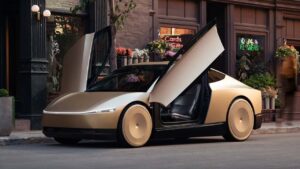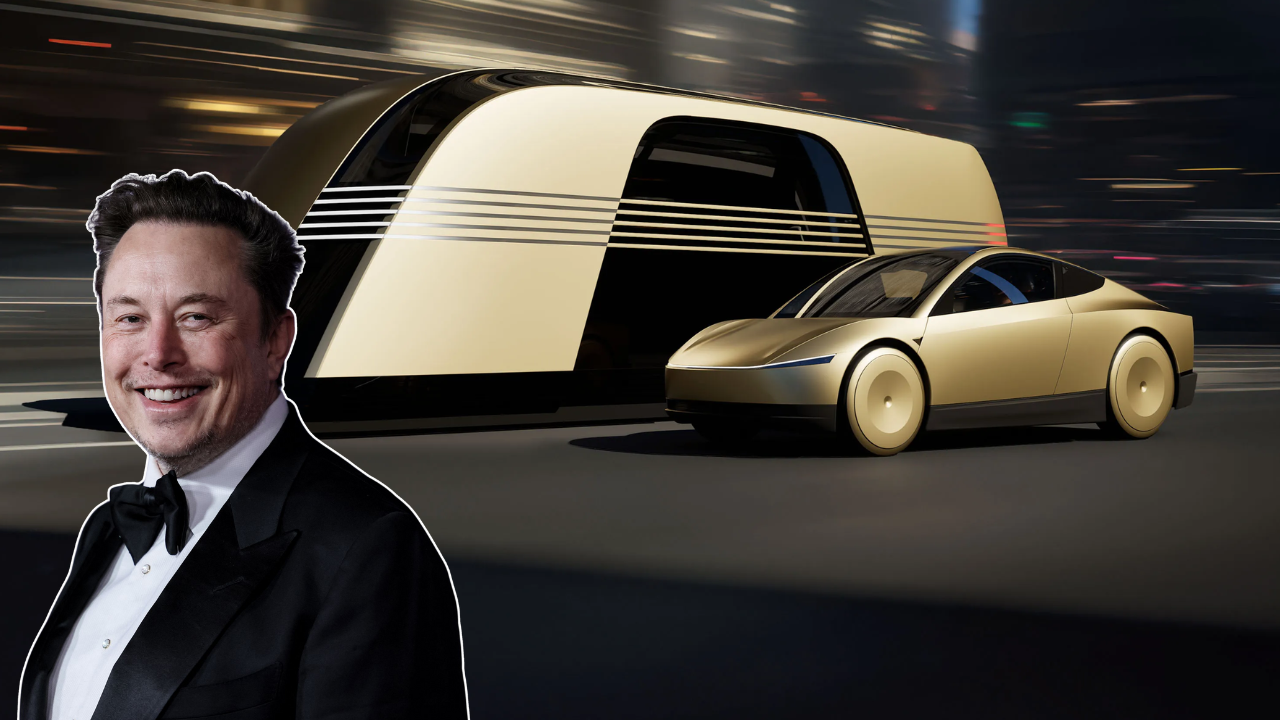On June 22, 2025, Tesla made history by launching its much-anticipated Robotaxi service in Austin, Texas, marking the debut of the world’s first self-driving car powered by cutting-edge artificial intelligence. This milestone, led by CEO Elon Musk, fulfills a decade-long promise to deliver fully autonomous vehicles capable of transforming urban mobility. Unlike traditional ride-hailing services, Tesla’s Robotaxi operates without a human driver, relying solely on its advanced Full Self-Driving (FSD) Unsupervised software, custom AI chips, and a camera-based vision system. This article explores the groundbreaking features of the Tesla Robotaxi, its impact on the transportation industry, and the challenges it faces in a competitive and regulated landscape.
The Dawn of Autonomous Mobility
Tesla’s Robotaxi service began with a modest fleet of approximately 10 to 20 Model Y SUVs, each equipped with the latest version of FSD Unsupervised. These vehicles, adorned with a stylized “Robotaxi” logo, were spotted navigating Austin’s South Congress neighborhood, seamlessly handling intersections and pedestrian crossings without human intervention. The launch, described by Musk as the “culmination of a decade of hard work,” represents a significant leap forward in autonomous driving technology.

The service is initially invite-only, primarily for Tesla employees and select influencers, with plans to expand to the general public in the coming months. A Tesla Safety Monitor occupies the passenger seat during the pilot phase, ensuring oversight while the company fine-tunes its technology. Musk has emphasized safety, stating on X that Tesla is “super paranoid” about ensuring the system’s reliability, which could delay broader rollout if issues arise.
Next-Gen AI: The Heart of the Robotaxi
At the core of the Tesla Robotaxi is its next-generation AI, which sets it apart from competitors like Waymo, Zoox, and Cruise. Unlike rival systems that rely on a combination of LiDAR, radar, and high-definition mapping, Tesla’s approach is vision-only, using cameras and neural networks to interpret the environment. This strategy, championed by Musk, mimics human driving by processing visual data through advanced AI, reducing hardware costs and enabling scalability.
Key AI Features
|
Feature |
Description |
Benefit |
|---|---|---|
|
FSD Unsupervised V13 |
End-to-end neural network for real-time decision-making, no human supervision. |
Eliminates need for driver intervention, enhances autonomy. |
|
Tesla Vision |
Camera-based system processes 360° visuals, replacing LiDAR and radar. |
Lower costs, scalable for mass production. |
|
Custom AI Chip (HW 5.0) |
In-house chip with 240 TOPS, optimized for neural network processing. |
Faster, efficient computations for complex driving scenarios. |
|
Actually Smart Summon |
Allows vehicle to navigate parking lots autonomously to pick up passengers. |
Improves user convenience, reduces wait times. |
|
Real-World AI Training |
Uses data from millions of Tesla vehicles to refine algorithms. |
Continuous improvement, handles edge cases better over time. |
The FSD Unsupervised V13 software is a game-changer, enabling the Robotaxi to handle complex urban environments, from navigating traffic signals to avoiding pedestrians. Tesla’s custom AI chip, designed specifically for autonomous driving, ensures low-latency processing, critical for real-time decision-making. The Actually Smart Summon feature, rolled out earlier in 2025, allows the vehicle to exit parking spaces and reach passengers autonomously, enhancing user experience.
Tesla’s reliance on a massive dataset collected from its global fleet gives it a competitive edge. Unlike Waymo, which operates smaller fleets with extensive pre-mapping, Tesla’s generalized approach allows its vehicles to adapt to new environments with minimal prior data. This scalability is key to Musk’s vision of deploying “millions of Teslas” as autonomous taxis by mid-2026.
The Austin Launch: A Strategic Choice
Austin, Tesla’s home base, was a strategic choice for the Robotaxi launch. The city’s tech-savvy population, wide roads, and supportive regulatory environment make it an ideal testing ground. Texas’s 2017 legislation, which prohibits cities from regulating autonomous vehicles, has fostered a permissive landscape for companies like Tesla, Waymo, and Avride. However, recent legislative changes, signed into law by Governor Greg Abbott on June 20, 2025, require autonomous vehicle operators to obtain state permits and provide emergency protocols, signaling a shift toward cautious oversight.
The pilot operates within a geofenced area of Austin, focusing on “the safest” parts of the city, as Musk noted in a CNBC interview. Remote teleoperators monitor the fleet, ready to intervene in emergencies, though Tesla aims to reduce reliance on human oversight as confidence in the system grows.
Competitive Landscape
Tesla enters a crowded field, with Waymo leading the pack. Waymo’s driverless taxis, operational in Phoenix, San Francisco, and Austin, have completed over 250,000 paid trips weekly, setting a high bar. Competitors like Zoox and Avride are also testing autonomous vehicles in Austin, while Volkswagen and Uber plan to expand their robotaxi services.
Tesla’s cost advantage—driven by its camera-only strategy and custom silicon—positions it to offer rides at a lower price point, potentially undercutting Uber and Lyft’s human-driven services. Musk has projected that Robotaxi rides could cost less than a bus ticket, making them accessible to a broad audience. However, competitors’ use of LiDAR and radar raises questions about Tesla’s ability to match their safety records, especially in edge cases like poor weather or rare road scenarios.
Safety and Regulatory Challenges
Safety remains a critical concern. Tesla’s FSD system, the foundation of the Robotaxi, has faced scrutiny from the National Highway Traffic Safety Administration (NHTSA), which reported 542 crashes, including 14 fatalities, involving Autopilot or FSD between 2018 and 2023. A recent NHTSA investigation is examining the Robotaxi’s performance in adverse conditions like fog or sun glare, following a fatal pedestrian crash.
Public skepticism is another hurdle. Protests organized by groups like The Dawn Project and Tesla Takedown on June 12, 2025, in Austin highlighted concerns about FSD’s safety, with demonstrators showcasing alleged software defects. Public opinion polls indicate declining trust in autonomous vehicles, exacerbated by high-profile incidents involving competitors like Cruise, which suspended its service after a 2023 accident.
The new Texas law, effective September 1, 2025, requires Level 4 autonomy—where vehicles can operate without a driver under specific conditions—posing a certification challenge for Tesla. While Texas permits are easier to obtain than California’s, they can be revoked if safety issues arise, adding pressure to deliver a flawless system.
Economic and Social Impact
The Robotaxi service has the potential to disrupt the transportation industry. By offering low-cost, driverless rides, Tesla could challenge Uber and Lyft, whose drivers face economic pressures. Analysts estimate the global robotaxi market could reach €450 billion by 2035, with Tesla’s scalable model positioning it as a frontrunner.
Socially, the service promises to enhance safety for vulnerable road users like pedestrians and cyclists by eliminating human errors like road rage or distracted driving. Tesla’s X post on June 23, 2025, emphasized this, claiming the Robotaxi “will greatly increase safety.” However, the transition to autonomy could displace jobs, raising questions about retraining programs for drivers.
The Road Ahead
Musk’s vision extends beyond Austin. He plans to expand the Robotaxi service to Los Angeles and San Francisco by late 2025, with hundreds of thousands of vehicles operational by mid-2026. The Cybercab, a purpose-built autonomous taxi without a steering wheel, unveiled at Tesla’s “We, Robot” event in October 2024, is slated for production in 2026, further streamlining costs.
However, Tesla must navigate technical, regulatory, and public perception challenges. The company’s decision to pivot from a low-cost EV to prioritize robotaxis has drawn criticism, with some analysts questioning whether Musk’s ambitious targets are realistic. Goldman Sachs predicts Tesla will have only 2,500 robotaxis by 2027, far below Musk’s projections.
In Summary
Tesla’s Robotaxi launch is a bold step toward a driverless future, powered by next-gen AI that redefines autonomous mobility. While the technology showcases remarkable innovation, its success hinges on proving safety, gaining regulatory approval, and winning public trust. As Tesla competes in a dynamic market, the Robotaxi could reshape how we move, making transportation safer, cheaper, and more accessible—or it could stumble under the weight of its own ambitions. For now, Austin’s streets are the proving ground for a revolution that could change the world.

